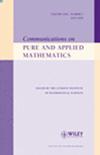4维及以上层次|φ|4$|\varphi |^4$模型的边界条件和通用有限尺寸标度
IF 2.7
1区 数学
Q1 MATHEMATICS
引用次数: 0
摘要
我们分析并阐明了在自由边界条件和周期边界条件下,所有维度上的所有整数的弱耦合层次分量模型的有限尺度。对于,我们证明了对于具有周期边界条件的体积大小,无限体积临界点是有效的有限体积临界点,而对于自由边界条件,有效临界点移动了一定的阶数。对于这两种边界条件,平均场在有效临界点周围的临界宽度窗口内具有相同的非高斯极限,并在该窗口内计算了磁化率的通用标度曲线。相反,对于两种边界条件,平均场在有效临界点以上一定数量时具有巨大的高斯极限。特别地,在无限体积临界点处,磁化率随周期边界条件和自由边界条件的变化而变化。我们确定了自由边界条件的质量生成机制,这是造成这种区别的原因,我们认为它具有更广泛的有效性,特别是在维度上的欧几里得(非分层)模型。因为我们用对数修正证明了一个类似的图。我们的分析基于Bauerschmidt, bridges和Slade的严格重整化群方法,并对其进行了改进和扩展。本文章由计算机程序翻译,如有差异,请以英文原文为准。
Boundary conditions and universal finite‐size scaling for the hierarchical |φ|4$|\varphi |^4$ model in dimensions 4 and higher
We analyse and clarify the finite‐size scaling of the weakly‐coupled hierarchical ‐component model for all integers in all dimensions , for both free and periodic boundary conditions. For , we prove that for a volume of size with periodic boundary conditions the infinite‐volume critical point is an effective finite‐volume critical point, whereas for free boundary conditions the effective critical point is shifted smaller by an amount of order . For both boundary conditions, the average field has the same non‐Gaussian limit within a critical window of width around the effective critical point, and in that window we compute the universal scaling profile for the susceptibility. In contrast, and again for both boundary conditions, the average field has a massive Gaussian limit when above the effective critical point by an amount . In particular, at the infinite‐volume critical point the susceptibility scales as for periodic boundary conditions and as for free boundary conditions. We identify a mass generation mechanism for free boundary conditions that is responsible for this distinction and which we believe has wider validity, in particular to Euclidean (non‐hierarchical) models on in dimensions . For we prove a similar picture with logarithmic corrections. Our analysis is based on the rigorous renormalisation group method of Bauerschmidt, Brydges and Slade, which we improve and extend.
求助全文
通过发布文献求助,成功后即可免费获取论文全文。
去求助
来源期刊
CiteScore
6.70
自引率
3.30%
发文量
59
审稿时长
>12 weeks
期刊介绍:
Communications on Pure and Applied Mathematics (ISSN 0010-3640) is published monthly, one volume per year, by John Wiley & Sons, Inc. © 2019.
The journal primarily publishes papers originating at or solicited by the Courant Institute of Mathematical Sciences. It features recent developments in applied mathematics, mathematical physics, and mathematical analysis. The topics include partial differential equations, computer science, and applied mathematics. CPAM is devoted to mathematical contributions to the sciences; both theoretical and applied papers, of original or expository type, are included.

 求助内容:
求助内容: 应助结果提醒方式:
应助结果提醒方式:


